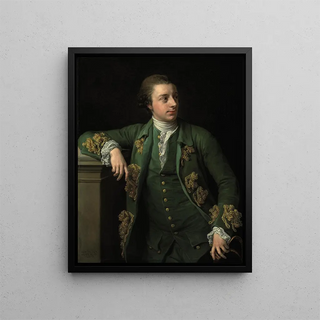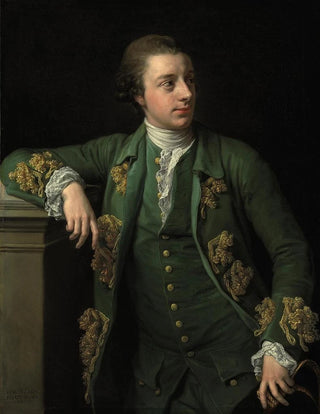Art print | Portrait of Thomas Fortescue - Pompeo Batoni


View from behind

Frame (optional)
Portrait of Thomas Fortescue by Pompeo Batoni – Captivating Introduction
The "Portrait of Thomas Fortescue" by Pompeo Batoni is a work that transcends the simple framework of a pictorial representation to become a window into the soul of a man and an era. Created in the 18th century, this painting embodies the essence of aristocratic portraiture, capturing not only the physical features of its subject but also his social status and aspirations. As viewers contemplate this piece, they are invited to immerse themselves in a world where elegance and refinement are the guiding principles, where every detail is carefully orchestrated to tell a story. The soft light caressing Fortescue's face, the sumptuous drapery of his attire, and the subtly crafted background create an atmosphere that is both intimate and majestic, showcasing the undeniable talent of the artist.
Style and uniqueness of the work
Batoni's style is distinguished by his ability to blend classicism with a touch of modernity, resulting in a striking portrayal of his model's personality. In the "Portrait of Thomas Fortescue," there is an impressive mastery of light and shadow play, which brings the subject's face to life. The eyes, bright and expressive, seem to follow the viewer, while Fortescue's enigmatic smile hints at rare psychological depth. The drapery of his costume, with its delicate textures, is painted with precision that reflects meticulous attention to detail. Batoni thus manages to create an atmosphere of dignity and nobility, while infusing a human dimension into his subject. This work also stands out for its use of color, where warm, rich tones contribute to an ambiance that is both welcoming and solemn.
The artist and his influence
Pompeo Batoni, an emblematic figure of 18th-century Italian painting, captured the spirit of his time while influencing many artists across Europe. His career, marked by solid training and travels throughout Italy and beyond, allowed him to develop a unique style that combines tradition and innovation. Batoni was particularly appreciated by the aristocracy of his era, which saw

Matte finish

View from behind

Frame (optional)
Portrait of Thomas Fortescue by Pompeo Batoni – Captivating Introduction
The "Portrait of Thomas Fortescue" by Pompeo Batoni is a work that transcends the simple framework of a pictorial representation to become a window into the soul of a man and an era. Created in the 18th century, this painting embodies the essence of aristocratic portraiture, capturing not only the physical features of its subject but also his social status and aspirations. As viewers contemplate this piece, they are invited to immerse themselves in a world where elegance and refinement are the guiding principles, where every detail is carefully orchestrated to tell a story. The soft light caressing Fortescue's face, the sumptuous drapery of his attire, and the subtly crafted background create an atmosphere that is both intimate and majestic, showcasing the undeniable talent of the artist.
Style and uniqueness of the work
Batoni's style is distinguished by his ability to blend classicism with a touch of modernity, resulting in a striking portrayal of his model's personality. In the "Portrait of Thomas Fortescue," there is an impressive mastery of light and shadow play, which brings the subject's face to life. The eyes, bright and expressive, seem to follow the viewer, while Fortescue's enigmatic smile hints at rare psychological depth. The drapery of his costume, with its delicate textures, is painted with precision that reflects meticulous attention to detail. Batoni thus manages to create an atmosphere of dignity and nobility, while infusing a human dimension into his subject. This work also stands out for its use of color, where warm, rich tones contribute to an ambiance that is both welcoming and solemn.
The artist and his influence
Pompeo Batoni, an emblematic figure of 18th-century Italian painting, captured the spirit of his time while influencing many artists across Europe. His career, marked by solid training and travels throughout Italy and beyond, allowed him to develop a unique style that combines tradition and innovation. Batoni was particularly appreciated by the aristocracy of his era, which saw






